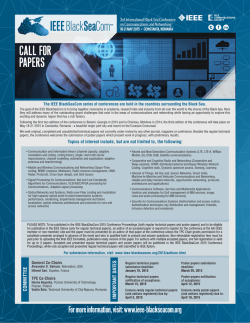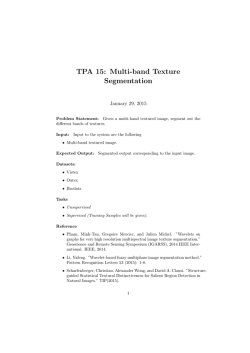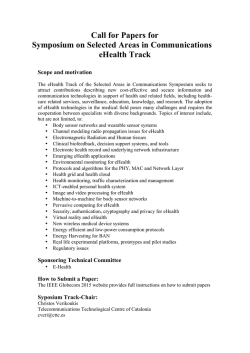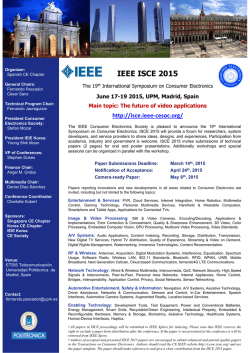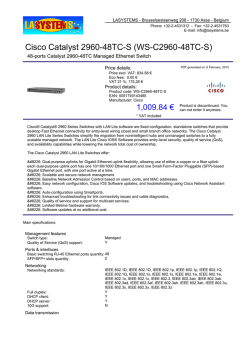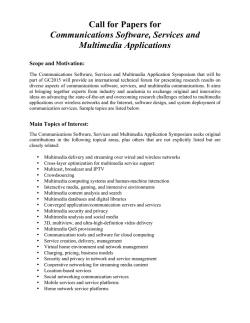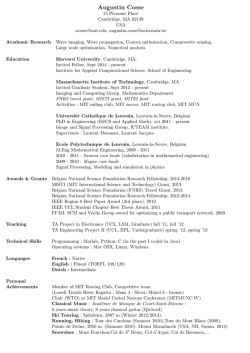
Call for Papers for Communication QoS, Reliability and Modeling
Call for Papers for Communication QoS, Reliability and Modeling Symposium Scope and Motivation: In modern communication networks, different technologies need to cooperate with each other for end-to-end quality of service (QoS) provisioning, support a wide range of multi-media applications with a huge number of customers, and should support user roaming and mobility. The Communication QoS, Reliability and Modeling (CQRM) Symposium aims at providing an international venue for the discussion of research advances in communications service provisioning, quality of service/experience technologies, and analytical and experimental techniques to allow the design of communication networks as a reliable information infrastructure with QoS capability. The scope of this symposium is agnostic to network technologies. Specifically, the goal is to address the key challenges to provide the required level of QoS to coexisting networks that are heterogeneous in the node characteristics, in the number of nodes, and in the type of information transmitted. Main Topics of Interest: • • • • • • • • • • • Application / Service Oriented Networking Cross-layer Design, Modeling and Optimization Design of Networks and Network Services Design of Software Defined Networks Measurement and evaluation techniques of energy efficient networks Measurement and evaluation techniques of energy efficiency in communication systems Metrics and Models for Quality of Experience (QoE) Mobile performance MPEG-DASH streaming Multipath TCP Network design and evaluation of Energy Efficient (Green) networks • • • • • • • • • • • • • • • • • • • • • • • Network Measurement and Monitoring Techniques Network Modeling Network Simulation Techniques Performance evaluation and design of cloud networks Performance evaluation and design of cognitive network architectures Performance evaluation and integration in Smart Grids communications Performance Evaluation Techniques Quality in Multimedia Networks including Voice over IP and IPTV Quality, Scalability and Performance in the Internet Quality and Performance in Wireless and Mobile Networks Quality, Reliability and Performance in Optical and Multi-layer Networks Quality and Performance in Autonomic Systems Quality and Performance in Grid, Distributed and Cloud Computing Quality and Performance in Overlay (including Peer-to-Peer) Networks Quality and Performance for Network and Services Quality and Resource Allocation for Network Services, VPN, Web Resource Allocation for Networks and their services Scalability, Robustness and Resilience Software-Defined Networking (SDN), and Network functions Virtualization (NFV) Standardization Aspects of QoS and Reliability TCP/IP Variants and Performance Quality, measurements and Performance in the Internet of Things Quality, measurements and Performance in Cyber Physical Systems Sponsoring Technical Committees: • Communications Systems Integration & Modeling (CSIM) • Communications Quality & Reliability (CQR) How to Submit a Paper: The IEEE Globecom 2015 website provides full instructions on how to submit papers. You will select the desired symposium when submitting. The paper submission deadline is April 1, 2015. Unlike recent ICC’s and Globecom’s, this is a hard deadline that will not be extended. Symposium Co-Chairs: • Stefano Giordano, University of Pisa, Italy, [email protected] • Kohei Shiomoto, NTT, Japan, [email protected] • Giorgio Quer, University of California, San Diego, [email protected] Biographies: Stefano Giordano Stefano Giordano is associate professor at the Department of Information Engineering of the University of Pisa where he is the responsible of the telecommunication networks laboratories. He is senior member of the IEEE Comsoc (member from 1989) and Chair of the Communication Systems Integration and Modeling (CSIM) Technical Committee. He is member of IFIP WG 6.3 and of the ISOC (Internet Society) since its foundation in 1992. His main research interest are related to traffic measurement, characterization and control in broadband multimedia networks. He is associate editor of the Wiley’s International Journal on Communication Systems and of the Journal of Communication Software and Systems technically co-sponsored by the IEEE Communication Society. He participated in many national and international project related to traffic measurements and control in telecommunication networks. From his research group two spin-off companies were generated (namely Nextworks and Netresults) together with a consortium of companies were he is at present chair of the scientific and technical commission (Cubitlab). He was recently nominated by IEEE chair of a Research Group on stardardization actions in the sector of IoT. Kohei Shiomoto Dr. Kohei Shiomoto (M’89) received the B.E., M.E., and Ph.D degrees in information and computer sciences from Osaka University, Osaka in 1987 1989, and 1998, respectively. Currently he is a Senior Manager of Communication & Traffic Service Quality Project, NTT Network Technology Laboratories, NTT, Tokyo, Japan. He joined NTT in 1989. He was involved in research and development of ATM switching system and ATM traffic control from 1989 to 1995 at NTT Labs. From 1996 to 1997, he was engaged in research on high-speed networking as Visiting Scholar at Washington University in St. Louis, MO, USA. He was directing architecture design for high-speed IP/MPLSlabel switching router research project at NTT Labs from 1997 to 2001. He was engaged in research of photonic IP router design, routing algorithm, and GMPLS routing and signaling standardization for the IETF at NTT Labs from 2001 to 2011. He has been engaged in research of traffic and quality management in network at NTT Labs from 2011. He co-authored "GMPLS Technologies: Broadband Backbone Networks and Systems (Optical Engineering)" Marcel Dekker Inc. He is a Fellow of IEICE and a member of IEEE, and ACM. He is the Chair of Chapter Coordination Committee of the Asia Pacific Board of the IEEE Communications Society (IEEE ComSoc APB). He has been continuously serving various positions including Information Services Committee Chair in the IEEE ComSoc APB since 2004. He served Technical Program Committee members of a number of IEEE conferences including Globecom/ICC. He received the Young Engineer Award from the IEICE in 1995. He received the Switching System Research Award from the IEICE in 1995 and 2001. Giorgio Quer (S’06, M’12) was born in Asolo, Italy, on July 27th, 1983. He received the B.Sc. degree, the M.Sc. degree (with honours) in Telecommunications Engineering and the Ph.D. degree in Information Engineering from University of Padova, Italy, in 2005, 2007 and 2011, respectively. In 2007 he was a visiting researcher at the Centre for Wireless Communication at University of Oulu, Finland, where he performed research on forwarding and routing techniques for wireless sensor networks. During his PhD studies his research has been focused on wireless networks optimization, as part of the EU-funded SENSEI project and in collaboration with DOCOMO Euro-Labs, Munich, Germany. In 2010 he was a visiting scholar at Calit2, University of California San Diego (UCSD), working on learning techniques for cognitive networks within the military-funded AROCogNet project. Since 2011, he is a postdoc researcher at UCSD. He serves as a reviewer for several IEEE and ACM transactions. His research interests include wireless sensor networks, compressive sensing, wireless network optimization, cognitive networking, signal processing, and wireless health. TPC Members Christer Ahlund, Lulea University of Technology, Sweden Ahmet Akyamac, Bell Labs, Alcatel-Lucent, USA Luigi Atzori, University of Cagliari, Italy Mauro Biagi, Sapienza University of Rome, Italy Benny Bing, Georgia Institute of Technology, USA Torsten Braun, University of Bern, Switzerland Periklis Chatzimisios, University of Macedonia, Greece Prosper Chemouil, Orange Labs, France Lydia Chen, IBM Zurich Research Laboratory, Switzerland Qian-bin Chen, Chongqing university of Posts and telecommunications, P.R. China Thomas Chen, Swansea University, United Kingdom Piotr Cholda, AGH University of Science and Technology, Poland Xiaowen Chu, Hong Kong Baptist University, Hong Kong Gerard Damm, Alcatel-Lucent, Portugal Carol Davids, Illinois Institute of Technology, USA Micheal Devetsikiotis North Carolina State University, USA Jerzy Domzal AGH University of Science and Technology, Poland Christos Douligeris, University of Piraeus, Greece Shu Du, Rice University, USA Qiang Duan, The Pennsylvania State University – Abington, USA Nelson Fonseca University of Campinas - Brasil Fabrizio Granelli, University of Trento, Italy Yu Gu, NEC Labs America, USA Go Hasegawa, Osaka University, Japan Toru Hasegawa, KDDI Labs, Japan Kenji Ishida, Hiroshima City University, Japan Susumu Ishihara, Shizuoka University, Japan Milosh Ivanovich, Chief Technology Office, Telstra, Australia Rittwik Jana, AT&T Labs Research, USA Hongbo Jiang, Huazhong University of Science and Technology, P. R. China Meilong Jiang, NEC Laboratories America, USA Burak Kantarci Clarkson University, USA Georgios Karagiannis, University of Twente, The Netherlands Helen Karatza, Aristotle University of Thessaloniki, Greece Ryoichi Kawahara NTT Service Integration Laboratories, Japan Kyungtae Kim, NEC Laboratories America, USA Dzmitry Kliazovich, University of Luxemburg King-Tim Ko, City University of Hong Kong, P. R. China Ioannis Lambadaris Carleton University, Canada Georgios Lazarou, Mississippi State University, USA Jie Li, University of Tsukuba, Japan Yun Li, ChongQing University of Posts and Telecommunications, P. R. China Xin Liu, Brookhaven National Laboratory, USA Andreas Maeder, NEC Laboratories Europe, Germany Damien Magoni, University of Bordeaux, France Anirban Mahanti, National ICT Australia, Australia Zoubir Mammeri, Paul Sabatier University, France Kenichi Mase, Niigata University, Japan Ashraf Matrawy, Carleton University, Canada Natarajan Meghanathan, Jackson State University, USA Michael Menth, University of Wuerzburg, Germany Michela Meo, Politecnico di Torino, Italy George Michailidis, University of Michigan, USA Daniele Miorandi, Create-Net, Italy Noriharu Miyaho, Tokyo Denki University, Japan Edmundo Monteiro, University of Coimbra, Portugal Kurenai Murakami, NEC Corporation , Japan Tutomu Murase, NEC Corporation, Japan Hajime Nakamura, KDDI R&D Laboratories Inc., Japan Kiyohide Nakauchi, National Institute of Information and Communications Technology, Japan Hidenori Nakazato, Waseda University, Japan Mohammad S.Obaidat, Monmouth University, USA Antonio Pescape, University of Naples, Italy Nischal Piratla, Deutsche Telekom, Inc. R&D Lab, USA Juergen Quittek, NEC Europe Ltd, Germany Joel Rodrigues, University of Beira Interior, Portugal Claudio Sacchi, University of Trento, Italy Xu Shao, Institute for Infocomm Research, Singapore Yantai Shu, Tianjin University, P. R. China Harry Skianis, University of the Aegean, Greece Dan Keun Sung, Korea Advanced Institute of Science and Technology, Korea Akira Takahashi, NTT Service Integration Laboratories, Japan Yukiko Takeda, Hitachi Ltd., Japan Shuji Tasaka, Nagoya Institute of Technology, Japan Takao Tashiro, OF Networks, Japan Petia Todorova, Fraunhofer-FOKUS, Germany Toshinori Tsuboi, Tokyo University of Technology, Japan Hiromi Ueda, Tokyo Univeisity of Technology, Japan Kiyoshi Ueda, NTT Network Service Systems Laboratories, Japan Christos Verikoukis, Telecommunications Technological Centre of Catalonia, Spain Naoki Wakamiya, Osaka University, Japan Junfeng Wang, Sichuan University, P. R. China Ning Wang, University of Surrey, United Kingdom Xinbing Wang, Shanghai Jiaotong University, P. R. China Zhongfeng Wang, Broadcom Corporation, USA Wei Wei, Ciena, USA Jing Wu, Communications Research Centre, Canada Yan Xin, NEC Laboratories America, USA Ke Xu, Tsinghua University, P. R. China Miki Yamamoto, Kansai University, Japan Katsunori Yamaoka, Tokyo Institute of Technology, Japan Tatsuya Yamazaki, National Institute of Information Communications Technology , Japan Tokumi Yokohira, Okayama University, Japan Tetsuya Yokotani, Mitsubishi Electric Corp., Japan Hong Zhang, InterDigital Communications, USA Yiqing Zhou, Applied Science and Technology
© Copyright 2025
